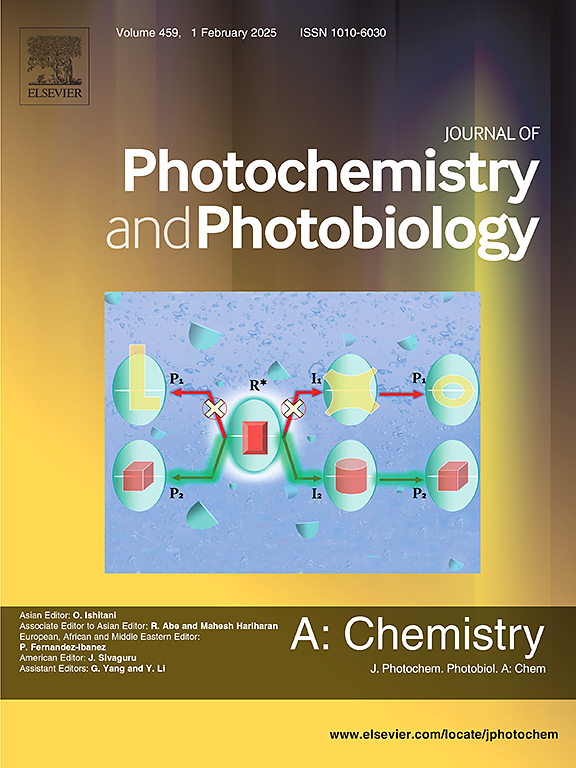氧合是超氧阴离子与色氨酸自由基反应的主要途径
IF 4.7
3区 化学
Q2 CHEMISTRY, PHYSICAL
Journal of Photochemistry and Photobiology A-chemistry
Pub Date : 2025-06-14
DOI:10.1016/j.jphotochem.2025.116571
引用次数: 0
摘要
氧的氧化作用,即氧的共价加成,是蛋白质最常见的化学修饰,导致其结构和功能的丧失。多肽和蛋白质中的色氨酸(TrpH)被认为是细胞氧化剂的主要电子来源之一,相应的色氨酸自由基可能具有很长的寿命。超氧阴离子(O2•-)与色氨酸自由基(Trp•)之间的反应是已知最快的Trp•双分子反应,可能导致TrpH的不可逆氧化。这个反应可以通过加成,生成氧合形式的TrpH,或者随着初始试剂的恢复而进行电子转移。目前,由于先前报道的结论相互矛盾,这种反应的机制尚不清楚。本研究旨在利用时间分辨光谱学方法在微秒时间尺度上观察反应过程,利用液相色谱-质谱法分析试剂降解和产物积累的过程,阐明该反应的机理。利用天然光敏剂犬尿酸经脉冲激光照射产生靶自由基。我们的时间分辨数据表明,TrpH在有氧条件下经历快速氧合,而没有显着恢复其基态。羟基过氧化物和n -甲酰基犬尿氨酸是TrpH降解的主要光产物。总之,我们的数据明确地表明,加成是超氧阴离子和色氨酸自由基之间反应的主要途径。将实验测量的试剂降解产率与动力学方案计算的产率进行比较,可以估计n -乙酰- l-色氨酸的加成/电子转移反应之间的比率为7/1。本文章由计算机程序翻译,如有差异,请以英文原文为准。

Oxygenation is the main pathway for the reaction between superoxide anion and tryptophan radical
Oxygenation, the covalent addition of oxygen, is the most common chemical modification of proteins, leading to the loss of their structure and functionality. Tryptophan (TrpH) within peptides and proteins is considered one of the main sources of electrons for cellular oxidants, and corresponding tryptophan radicals may have long lifetimes. The reaction between superoxide anion (O2•—) and tryptophan radicals (Trp•) is the fastest known bimolecular reaction of Trp•, which may lead to the irreversible oxygenation of TrpH. This reaction may proceed via the addition, yielding oxygenated forms of TrpH, or the electron transfer with the restoration of the initial reagents. Currently, the mechanism of this reaction remains unclear due to contradicting conclusions reported previously. This work aims to elucidate the mechanism of this reaction using methods of time-resolved optical spectroscopy to visualise processes on the microsecond time scale and liquid chromatography-mass spectrometry to analyse the reagent degradation and product accumulation. The target radicals were generated using natural photosensitiser kynurenic acid irradiated by pulsed laser radiation. Our time-resolved data demonstrated that TrpH undergoes rapid oxygenation under aerobic conditions without significant restoration of its ground state. Hydroxyperoxides and N-formyl-kynurenine were found to be major photoproducts of TrpH degradation. Altogether, our data unambiguously indicated the addition as the major pathway for the reaction between superoxide anion and tryptophan radicals. Comparison of experimentally measured yields of reagent degradation with those calculated from the kinetic scheme provided an opportunity to estimate the ratio between addition/electron transfer reactions as 7/1 for N-acetyl-L-tryptophan.
求助全文
通过发布文献求助,成功后即可免费获取论文全文。
去求助
来源期刊
CiteScore
7.90
自引率
7.00%
发文量
580
审稿时长
48 days
期刊介绍:
JPPA publishes the results of fundamental studies on all aspects of chemical phenomena induced by interactions between light and molecules/matter of all kinds.
All systems capable of being described at the molecular or integrated multimolecular level are appropriate for the journal. This includes all molecular chemical species as well as biomolecular, supramolecular, polymer and other macromolecular systems, as well as solid state photochemistry. In addition, the journal publishes studies of semiconductor and other photoactive organic and inorganic materials, photocatalysis (organic, inorganic, supramolecular and superconductor).
The scope includes condensed and gas phase photochemistry, as well as synchrotron radiation chemistry. A broad range of processes and techniques in photochemistry are covered such as light induced energy, electron and proton transfer; nonlinear photochemical behavior; mechanistic investigation of photochemical reactions and identification of the products of photochemical reactions; quantum yield determinations and measurements of rate constants for primary and secondary photochemical processes; steady-state and time-resolved emission, ultrafast spectroscopic methods, single molecule spectroscopy, time resolved X-ray diffraction, luminescence microscopy, and scattering spectroscopy applied to photochemistry. Papers in emerging and applied areas such as luminescent sensors, electroluminescence, solar energy conversion, atmospheric photochemistry, environmental remediation, and related photocatalytic chemistry are also welcome.

 求助内容:
求助内容: 应助结果提醒方式:
应助结果提醒方式:


